President's Environmental Youth Award (PEYA) 2016 Winners
EPA Region 1:
Synthesis of Low Cost, Biodegradable Masks/Bags Using Novel Material Combinations: A Sustainability Project
Connecticut
Team: PKN
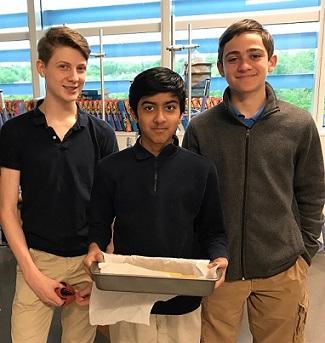 After reflecting on pollution problems in their own community and around the world, a group of 9th graders, calling themselves "PKN", decided to take matters into their own hands. The students were particularly concerned about air pollution and the large amount of petroleum-based plastics filling landfills, in their home community in Connecticut and abroad. PKN students especially noted people's use of inexpensive masks to filter out particulate matter in the air and the waste created by the disposal of these masks. In response, the students developed a low-cost biodegradable plastic using a local agricultural waste product-pumpkin. The team continues to explore options to commercially distribute masks made from this cost-efficient bioplastic. The group is also working to develop biodegradable plastic bags made from their innovative material.
After reflecting on pollution problems in their own community and around the world, a group of 9th graders, calling themselves "PKN", decided to take matters into their own hands. The students were particularly concerned about air pollution and the large amount of petroleum-based plastics filling landfills, in their home community in Connecticut and abroad. PKN students especially noted people's use of inexpensive masks to filter out particulate matter in the air and the waste created by the disposal of these masks. In response, the students developed a low-cost biodegradable plastic using a local agricultural waste product-pumpkin. The team continues to explore options to commercially distribute masks made from this cost-efficient bioplastic. The group is also working to develop biodegradable plastic bags made from their innovative material.
In the process of developing their bioplastic products, PKN engaged with members of their local community and global community. PKN partnered with a local farm to repurpose pumpkins that would otherwise be thrown away as waste at the end of the fall season. The group met with a local environmental technology company to further develop a business model for PKN's products. Along the way, the student group developed a mobile application to raise awareness among children of plastic pollution. Finally, on a global scale, the PKN team is exploring opportunities to donate future profits to an organization working to prevent suicide among Indian farmers.
EPA Region 2:
Creating a Mosquito Trap Using By-Products of Compost & Solar Power
New Jersey
Team: The Traposquitoes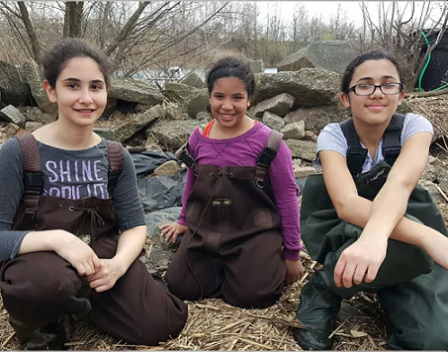
When considering how harmful mosquitoes can be to human populations, the "Traposquitoes," a group of three 8th graders from New Jersey, decided to take steps to make their own community safer. The students were concerned about the transmission of disease by mosquitoes, which can cause minor irritation and can spread major illnesses such as Zika and Malaria. The Traposquitoes aimed to educate people about the potential harm that the presence of mosquitoes can bring and to design a trap to help reduce mosquito populations in their community. Instead of the traditional electric mosquito traps, which are powered by electric currents from a house or by batteries, are limited in the areas they can be placed, and tend to be expensive, the Traposquitoes designed an efficient, new, environmentally-friendly trap. Their traps use the heat and CO2 from composting organic material to attract mosquitoes, along with a solar powered light and suction fan to trap them.
The group installed one of their traps at a local reservoir, and hosted educators and news media to see their project. The Traposquitoes also started a composting initiative at the Riverview Park Farmers Market to collect compost for use in their traps. The Traposquitoes were interviewed by the Honeywell Institute of Ecosystems Education and the Jersey Journal, and have continued to expand their outreach within the state. For their efforts, the Traposquitoes received the 2016 Governor's Environmental Excellence Award.
The Traposquitoes have already begun impacting the world beyond their community. They started a "Global Traposquito" initiative with the purpose of connecting with other students to reduce the global mosquito population. The Traposquitoes sent materials to construct a mosquito trap at the Julius E. Sprauve School in the Virgin Islands and will collaborate with students at this school via Skype. The Traposquitoes also produced an online video tutorial and instruction manual to assist others who wish to build their own versions, and educate local and global community members through YouTube, Facebook, Twitter, Instagram, and an online newsletter called "Traposquito Weekly." In the future, the Traposquitoes hope to expand their project even farther, with plans to develop a public park composting initiative.
EPA Region 3:
Save the Frogs and Toads
Pennsylvania
Team: Devin and Roldan K.
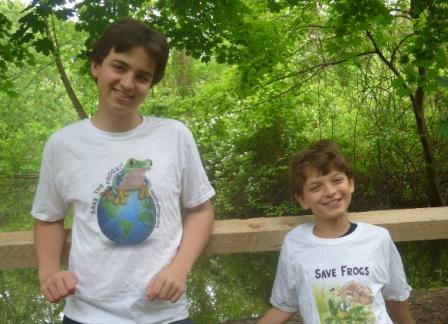 Brothers Devin and Roldan from Pennsylvania, have one goal in mind: to save frogs and toads. The brothers' interest was sparked by discussions about the number of mosquitoes in their area, and the decline of predators like bats, frogs and toads, which feed on mosquitoes.
Brothers Devin and Roldan from Pennsylvania, have one goal in mind: to save frogs and toads. The brothers' interest was sparked by discussions about the number of mosquitoes in their area, and the decline of predators like bats, frogs and toads, which feed on mosquitoes.
The brothers learned that each April, the swimming pool at their local park drains the water and ends up killing tadpoles living in the pool before they can mature. To increase the population of native frogs and toads, Devin and Roldan took approximately 2,000 tadpoles from the pool in April and raised them to the frog and toad stage. They monitored an aquarium with a filtration system and collected fruit flies from a compost bin to feed the growing frogs and toads. The brothers then released them into their native habitats in July and August. Over the course of their project, the brothers observed their aquarium closely, protected the tadpoles from predators, and transferred the tadpoles to a larger aquarium as they grew legs.
To raise awareness about their project, Devin and Roldan distributed informational cards to a troop of Cub Scouts about designing effective pools for tadpole growth. They also engaged the troop members in educational games about frogs and toads. At their church's national reunion at Deer Park, the brothers presented their project to children from around the country, inviting them to watch the release of the mature frogs and toads. As a result of their project, Devin and Roldan have observed not only an increase in frog and toad populations, but improvement in the overall ecosystem, with a decrease in the number of mosquitoes and a growing number of native animals, such as snakes, fish, and birds.
Healthy and Sustainable Farming Practices
Virginia
Team: George Mason High School Environmental Group
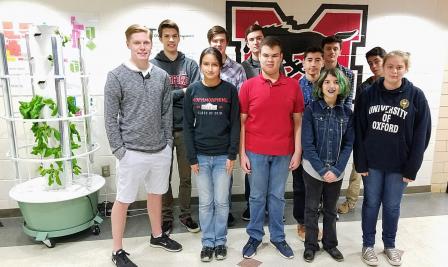 The George Mason High School (GMHS) Environmental Group, a group of 11 students in Northern Virginia, have worked for the past two years to implement two projects, with a focus on providing healthy, sustainable food sources that can be produced in an urban area. Through a hydroponics project and an aquaculture project, the students are contributing fresh lettuce and in the future, fresh fish to their high school cafeteria.
The George Mason High School (GMHS) Environmental Group, a group of 11 students in Northern Virginia, have worked for the past two years to implement two projects, with a focus on providing healthy, sustainable food sources that can be produced in an urban area. Through a hydroponics project and an aquaculture project, the students are contributing fresh lettuce and in the future, fresh fish to their high school cafeteria.
Interest in urban sustainability began after the students received a grant from the Chesapeake Bay Foundation to work with soil scientists from the Northern Virginia Soil and Water Conservation District on ways to reduce water runoff in urban areas. From this project, the GMHS Environmental Group became interested in other urban sustainable practices and received a "Super Grant" from the Falls Church Education Foundation to design and implement a hydroponics and aquaculture project at their high school and a local middle school. Hydroponics, which is the process of growing plants in a soilless media, and aquaculture, the process of raising fish in a closed environment, promote the growth of crops and fish with lower need for pesticides, insecticides, or herbicides. In order to encourage healthy eating, the GMHS Environmental Group decided to plant lettuce and raise tilapia for their school cafeteria.
From their hydroponics and aquaculture project, the GMHS Environmental Group has produced over 60 pounds of lettuce served in their school cafeteria, and expect the first harvest of tilapia in Fall 2017, with plans to supply a consistent tilapia harvest in the future. For their efforts, the students were awarded the Project Green Schools award for Outstanding Commitment to Green-o-vation. The team has presented their work to the Falls Church City 4H Club, the Falls Church Garden Club, and science teachers in Northern Virginia, as well as at the 2015 and 2016 Student Environmental Action Showcase at George Mason University.
EPA Region 4:
#Share a Book #Save a Forest #Change a Life
Florida
Team: Chase H. and Vance T.
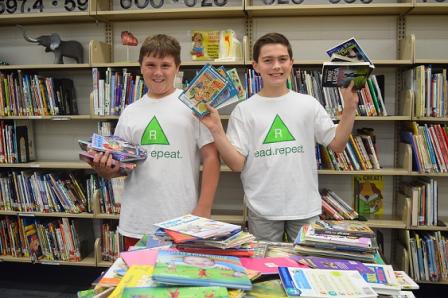 When 5th grade friends Chase and Vance came across a bin of a thousand books heading to the landfill, while knowing that some community members had no books, these two students set out to solve both problems at once. Calling their partnership "read.repeat", Chase and Vance successfully collected, sorted and repurposed over 25,000 books in six months, taught thousands of community members about recycling and repurposing, and kept thousands of pounds of waste from entering the landfill.
When 5th grade friends Chase and Vance came across a bin of a thousand books heading to the landfill, while knowing that some community members had no books, these two students set out to solve both problems at once. Calling their partnership "read.repeat", Chase and Vance successfully collected, sorted and repurposed over 25,000 books in six months, taught thousands of community members about recycling and repurposing, and kept thousands of pounds of waste from entering the landfill.
Chase and Vance researched the lifecycle of books, learning about the amount of wood needed to create a book, the challenges to recycling them (due to glue in the bindings), and the estimated 300 million books discarded into landfills each year. They began collection of gently used books, getting word out into their community through their website readrepeat.org, complete with a program logo to enhance community recognition of the project. They made presentations to their school, their Cub Scout Pack, a martial arts studio, their local National Elementary Honor Society chapter, and other community groups. Chase and Vance even approached the source of the original bin of books that inspired their effort and convinced the company to donate leftover inventory rather than dispose of it. When donations came pouring in, they enlisted friends and family to sort, pack, and deliver thousands of books to community members in need, at places like a homeless shelter, a local VA Hospital, local libraries and schools, and foster and group homes.
Chase and Vance surpassed their initial goal, donated books to 32 organizations across three states, and brought the joy of reading to more than 5,000 individuals. With more than 80 volunteers and involvement from local businesses and media, they made a meaningful impact in their community and environment by keeping waste out of landfills and teaching others to #Share a Book #Save a Forest #Change a Life. In the future, they hope to expand their reach nationally to repurpose 50,000 books annually.
Citizen Science in High Schools Aimed at Water Quality Testing
South Carolina
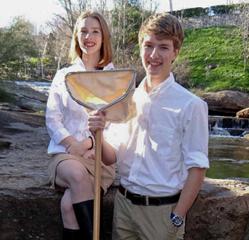 Team: Rachel and Adam E.
Team: Rachel and Adam E.
In South Carolina, two high school students Rachel and Adam implemented a Georgia citizen science initiative into their respective Greenville high schools, calling on fellow students to take charge in their watershed in order to prevent potential environmental health catastrophes. The program, Georgia's Adopt-A-Stream, is an initiative that trains individuals and groups in standardized water testing protocols. Once trained, citizens take monthly trips to their stream site(s) and sample for Dissolved Oxygen (DO), pH, conductivity, turbidity, and E. coli bacteria levels. Data is posted to a public database for analysis and baseline data storage.
Rachel and Adam's interest in environmental protection and citizen science began as young children, participating in programs like Frog Watch USA and 4H. When their interest in water quality was peaked, they sought to bring a Georgia citizen science initiative to South Carolina. They coordinated a cross-border training session for certification in chemical and macroinvertebrate water monitoring. They initially picked up three sites from across the county and started reporting monthly data to Georgia's public database. Rachel and Adam expanded their interest to their high school years, starting initiatives to monitor the stream running through the heart of their city, with the involvement of science teachers and other students. Over time, Rachel and Adam expanded their work, involving students from their area in routine monitoring. They conceptualized a plan to execute a county-wide survey of streams for possible E. coli bacteria hotspots. Eighteen sites were selected due to their proximity to industry, roads, known sources of pollution, and animal waste. Several students from area high schools collected, plated, and assessed samples from each of the eighteen sites. Along the way, involved students have benefitted from open conversations with local environmental professors and officials, and gained exposure to potential career paths. Through their monitoring initiatives over the years, two broken sewer lines have been discovered and repaired which further demonstrates the real world value of citizen science.
Rachel and Adam continue to share their knowledge and encourage their peers and teachers to participate in these environmental stewardship efforts, through promoting inclusion of water monitoring curriculum in Greenville County schools, doing public appearances on local television, and sharing awareness of resources, funds, and supplies. South Carolina has now developed its own Adopt-A-Stream program.
EPA Region 5:
Greenversal Environmental News Reports
Michigan
Megan H.
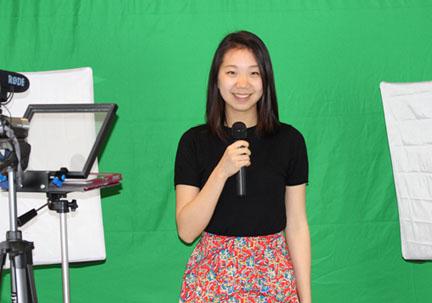 Megan, an 11th-grader in Michigan, was disappointed in the general lack of exciting video content she could find featuring environmental news. Megan determined that a lack of public interest in environmental issues was reflected in how little environmental news was covered in the media. In an effort to counter public apathy, Megan began a weekly environmental news YouTube channel called Greenversal, where she creates, edits, and publishes short videos each week highlighting environmental news topics in an engaging and viewer-friendly way. Drawing inspiration from her favorite news anchors, Greenversal features Megan's news reports on environmental issues she's researched, including relevant photos and video clips. She also takes the time to read and engage with viewers' comments on her videos.
Megan, an 11th-grader in Michigan, was disappointed in the general lack of exciting video content she could find featuring environmental news. Megan determined that a lack of public interest in environmental issues was reflected in how little environmental news was covered in the media. In an effort to counter public apathy, Megan began a weekly environmental news YouTube channel called Greenversal, where she creates, edits, and publishes short videos each week highlighting environmental news topics in an engaging and viewer-friendly way. Drawing inspiration from her favorite news anchors, Greenversal features Megan's news reports on environmental issues she's researched, including relevant photos and video clips. She also takes the time to read and engage with viewers' comments on her videos.
Since launching her channel and accompanying website, Megan has reached viewers from over 100 countries around the world with more than 70,000 views. Viewers are utilizing the channel in creative ways, including a teacher of environmental literacy at a California jail, who uses Megan's weekly news reports as a resource for his students. Closer to home, Megan has broadcast the Greenversal channel to teachers at her own school and raised environmental awareness within her community. In the long term, Megan aspires to motivate others take action on environmental issues themselves.
EPA Region 6:
Caring for the Planet and Its Children in Need
Texas
Team: We Care Act
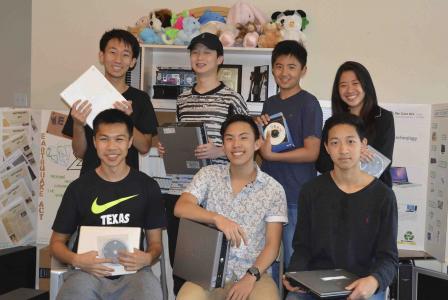 In the spring of 2008, when a 7.9 magnitude earthquake struck Sichuan, China, the idea for the "We Care Act" project was formed. Eric, now a high schooler, saw the images of devastation and committed to try to support children impacted by the earthquake through creating the project. Over time, students involved in We Care Act learned that disasters not only affect victims' immediate, everyday life but also alter their chances in the future due to a lack of access to items such as clothes, books, and electronics. We Care Act was formed to collect gently used items to help disaster victims, while protecting the environment.
In the spring of 2008, when a 7.9 magnitude earthquake struck Sichuan, China, the idea for the "We Care Act" project was formed. Eric, now a high schooler, saw the images of devastation and committed to try to support children impacted by the earthquake through creating the project. Over time, students involved in We Care Act learned that disasters not only affect victims' immediate, everyday life but also alter their chances in the future due to a lack of access to items such as clothes, books, and electronics. We Care Act was formed to collect gently used items to help disaster victims, while protecting the environment.
Over time, We Care Act developed a focus on electronics recycling, as participants learned that a lack of technology can be one of the major educational setbacks for disadvantaged groups. The team aimed to increase awareness about electronics recycling and organize others to recycle and reuse in order to increase access to technology for children in need. The We Care Act team learned how to check and assemble computers and wipe hard drives. They conducted recycling drives and refurbishing workshops, and expanded their scope beyond disaster relief. Within a few months, they refurbished 15 laptops for an inner-city school in Houston and set desktops to a children's home. They created an electronic educational survey, to educate students and adults, as well as visited community centers, reaching over 5000 people, collecting over 1100 responses from 50+ cities. We Care Act has now recycled over 7400 lbs. of electronics, delivering 163 refurbished/new computers, tablets, smart phones and other electronics to organizations and individuals in Nicaragua, China, Nepal and in the U.S., while supporting victims of 15 natural disasters.
EPA Region 7:
REVIVE Go Green-Reuse and Recycling of Pencils
Nebraska
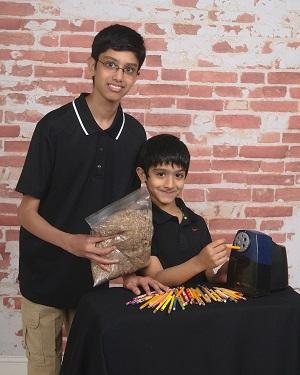 Team: Aryan M. and Om M.
Team: Aryan M. and Om M.
When 6th grader Aryan and Kindergartener Om realized how many of their partially used pencils were left over each year, it got them thinking about how many usable pencils end up in the trash and the number of trees cut down to make those pencils. After researching how certain types of waste can be transformed into compost, the brothers decided to implement a project in the Millard Public School District to promote environmental awareness and a habit of reusing and recycling school supplies, like pencils. The students named their project "REVIVE Go Green" to reflect the completion of the life cycle of a pencil, when composted pencils can be used to grow or revive new trees.
After learning that all parts of a wooden pencil can be recycled as compost (Ex. the "lead" in pencils is graphite, a rich source of potassium), the brothers worked with a local nursery, and the Aldrich Elementary School staff to set up a pencil recycling and composting program. All classes collected pencil shavings and pencil stubs, and the nursery recycled them into compost. In addition, Aryan and Om spent time after school each day sharpening hundreds of dull pencils for classes to reuse.
Inspired by the brothers' actions, students in other grades became involved as part of a REVIVE CLUB volunteer team; eventually, volunteer teams of older and younger students alike became involved in the collection process and the promotion of environmental awareness. On the last day of school, Aryan and Om collected pencils and were able to provide approximately 4,000 useable pencils for the next year's school supplies. For their efforts, they were awarded a special recognition letter from the Millard District Superintendent and Aldrich Principal. The brothers recently moved to New Jersey, where they plan on expanding the REVIVE Go Green project to their new school district, as well as supporting the continuation of their project at Aldrich Elementary.
EPA Region 8:
Food Waste Awareness at Douglass Elementary
Colorado
Team: The Food Waste Club
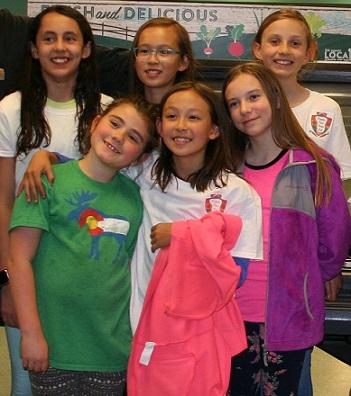 A group of 1st through 5th graders at Douglass Elementary, called the "Food Waste Club," took action to educate their fellow students about food waste and help reduce waste at their school in Colorado.
A group of 1st through 5th graders at Douglass Elementary, called the "Food Waste Club," took action to educate their fellow students about food waste and help reduce waste at their school in Colorado.
To begin, the Food Waste Club sent out a survey to other students at Douglass Elementary to gauge which foods students did or did not like, as well as their thoughts on portion size, hot versus cold lunches, how hungry they were at lunchtime, and noise level in the cafeteria. The team then conducted a waste audit, weighing food from the cafeteria to see how much food their school was wasting and discovered that many students were throwing away untouched fruits and vegetables. In response, the Food Waste Club created an "untouched food bin," where students place fruits and vegetables they haven't eaten to be washed and used in future lunches. To promote food waste awareness, members of the Food Waste Club prepared a video about food waste and being proactive in the lunch room, which was shared with other classes and put on the Douglass Elementary website.
Most recently, the Food Waste Club has been involved in the larger community, participating in a food reclamation campaign called Feeding the 5,000 Front Range. The group also presented their project the director of food services in the Boulder Valley School District, who asked the club to design food waste posters to be put up in all elementary schools in the district.
Watch and learn from the Food Waste Club how you can make a difference.Exit
A Small & Portable Air Dancer for Scaring Birds Away from Airports
Utah
Team: The Bionic Porcupines 2.0
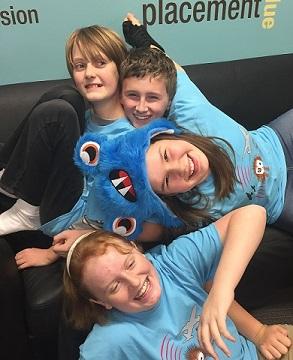 When 6th graders in Utah learned that hundreds of birds are killed by striking airplanes at the Salt Lake City International (SLC) Airport, they were determined to help decrease the number of birds flying near airports. Together they formed a team called the "Bionic Porcupines 2.0," to reduce bird strikes at SLC, which is located near a wetlands and a migratory bird route.
When 6th graders in Utah learned that hundreds of birds are killed by striking airplanes at the Salt Lake City International (SLC) Airport, they were determined to help decrease the number of birds flying near airports. Together they formed a team called the "Bionic Porcupines 2.0," to reduce bird strikes at SLC, which is located near a wetlands and a migratory bird route.
The group met with the airport wildlife staff, including the USDA airport biologist, to examine current methods to keep birds off the airport where birds tend to gather, including predator calls, robotic bait, and remote trap setting. They learned that one method of scaring birds away is to set up an air dancer- a large, brightly-colored tube that flaps when filled with air. However, large commercial air dancers tend to be expensive and require generators that contribute to pollution in the area.
In response, the Bionic Porcupines 2.0 created a small, portable, and battery-operated air dancer that is easily placed where birds nest and can run all day on a car battery. Through experimentation the team determined that it needed at least a 36" sock to get strong random motion. They tested various fans and air sock materials, as they sought to create a dancer that could be placed under bridges and floated out on ponds. They tested their design at the airport and found that the only day that geese did not gather was the day their air dancer was used. The Bionic Porcupines 2.0 now have a provisional patent for their design. The air dancer is small so it can be used at any airport in multiple locations, protecting birds from striking airplanes.
Watch the Bionic Porcupines 2.0 explain their creation.Exit
EPA Region 9:
Shore Wars- The Shore Awakens
California
Team: The Mount Madonna School
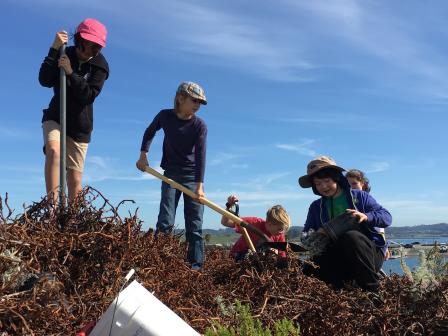 This student driven, integrated curriculum, project focused on environmental threats faced by the Western Snowy Plover, a threatened shorebird found along the California coastline. The students selected this topic as the focus of their work after researching a variety of local environmental topics. They were specifically concerned with habitat encroachment and pollution from plastic, both of which contribute to declining numbers of the bird.
This student driven, integrated curriculum, project focused on environmental threats faced by the Western Snowy Plover, a threatened shorebird found along the California coastline. The students selected this topic as the focus of their work after researching a variety of local environmental topics. They were specifically concerned with habitat encroachment and pollution from plastic, both of which contribute to declining numbers of the bird.
Over the course of the year, student teams worked with a local biologist to write reports, create displays and present to one another information on habitat, threats and conservation efforts. Students connected with community members by learning from and working with organizations such as Save our Shores, Point Blue Conservation Science, and the Elkhorn Slough Foundation. Students planned their project including elements of civic action, civic service, education, experimentation, fundraising, innovation and presentation. They formed a mock company to implement their plan, ultimately wrote and filmed a 30-minute educational film, which was sold to raise funds for the organizations supporting their project. The class presented to their school, to members of the community, to media, and to a local Assembly member. The class was chosen to participate in the Monterey Bay Aquarium Plastic Pollution summit to present their research to other students. From the summit, out of more than 150 schools, they were selected to present at World Ocean Day at the aquarium.
As the civic service piece of their project, the students worked to reestablish habitat at a local state beach by planting native plants, held fall and spring cleanups of habitat on another state beach, and created nesting indentations and camouflage in old salt flats near Elkhorn Slough. Additionally, they worked with the state park system to create educational signs to alert the public of wintering flocks of snowy plovers. With partners in the 9th grade, students created an experiment where a small-scale sand dune was designed and tested to assess its ability to hold a plover nest exposed to the elements. Aspects of engineering and upcycling were integrated into post cleanup classroom exercises.
The Grey Water Project
California
Shreya R.
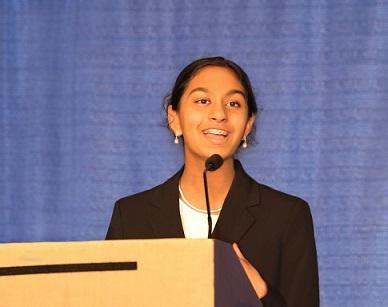 Having seen firsthand the effects of drought in California and in India, high-schooler Shreya formed the Grey Water Project to encourage people conserve and reuse water. Over three years of research into water conservation, Shreya has particularly focused on the possibility of reusing grey water, which is lightly used water, especially from laundry.
Having seen firsthand the effects of drought in California and in India, high-schooler Shreya formed the Grey Water Project to encourage people conserve and reuse water. Over three years of research into water conservation, Shreya has particularly focused on the possibility of reusing grey water, which is lightly used water, especially from laundry.
In her research, Shreya found that many commercial laundry detergents have harmful chemicals that can be detrimental to soil, plants, and aquatic life. So instead, she tested to see if grey water from soap nuts-a natural laundry detergent derived from the Indian soap berry-could be used as irrigation water without harming the environment. She tested the effects of soap nut grey water on aquatic life, soil and plants, using multiple tests and comparing grass exposed to regular water, soap-nut grey water, organic and non-organic detergent grey water. She found that soap nut grey water was beneficial to plant growth and cost less than an organic detergent.
Through the grey water project, including her website and Facebook page, Shreya reaches out to her community to educate people about water conservation. She has presented at her school and local elementary schools, as well as at a local water board. She has approached parent teacher organizations and local libraries in the hopes to present there as well. For her efforts, she has been recognized in the media and numerous awards at science fairs and competitions. Shreya is continuing to research grey water and to promote water conservation, and hopes to do so throughout her high school career.
EPA Region 10:
Bee Happy We Happy
Washington
Elizabeth S.
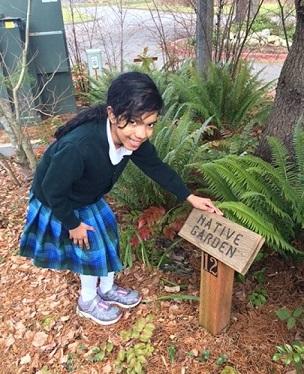 As part of the 5th grade science curriculum, Elizabeth learned about pollination and the importance of bees. The topic struck her curiosity and after encouragement from her teacher, Elizabeth embarked on an independent project to educate herself and her community about bee health and beekeeping.
As part of the 5th grade science curriculum, Elizabeth learned about pollination and the importance of bees. The topic struck her curiosity and after encouragement from her teacher, Elizabeth embarked on an independent project to educate herself and her community about bee health and beekeeping.
Titling her project "Bee Happy We Happy," Elizabeth did extensive research including reviewing articles, Washington State University Extension videos on pollination and pollinator protection, a TED talk, visiting a local nursery to understand cultivation, and reaching out to organizations and scientists as direct sources. Her research included sources such as the community Horticulture wing of the Department of Pest Management of Washington State University Extension, a chemical engineer in Oregon, and a biotechnologist in pharmaceuticals, which helped her to understand chemicals being used in modern agriculture and managing balanced biodiversity.
Following her research, to engage her community, Elizabeth created an awareness flier, and set out to distribute it across her school and community. Elizabeth shared actions that her community members could take to promote bee health, such as planting bee-friendly flowers, keeping "weeds," becoming a beekeeper, reducing pesticide use, and including water sources in a garden. She presented to her classmates and principal, and provided fliers to homeroom teachers to discuss with their science classes. At her local grocery, she engaged customers at the door by giving out her flier and discussing her concerns about bee health and how individuals could make a difference in protecting pollinators. Elizabeth plans to continue to get the message out to her family, friends and community to develop more "bee helpers" in her community.
Learn from Elizabeth how to protect pollinators in this video.Exit
Schools Under 2C
Washington
Team: Tesla STEM High School's Schools Under 2C
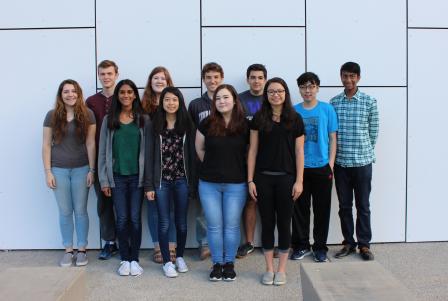 The student Leadership Team of Tesla STEM High School launched "Schools Under 2C," an organization dedicated to raising awareness about the environment amongst the younger generation. Consisting of over 100 students, Schools Under 2C have lead their school to reduce their carbon footprint by over a ton and a half each month. They have proved that reducing emissions is not only beneficial to the environment, but saves their school district money as well.
The student Leadership Team of Tesla STEM High School launched "Schools Under 2C," an organization dedicated to raising awareness about the environment amongst the younger generation. Consisting of over 100 students, Schools Under 2C have lead their school to reduce their carbon footprint by over a ton and a half each month. They have proved that reducing emissions is not only beneficial to the environment, but saves their school district money as well.
Through simple educational programs, the students have been igniting behavioral changes throughout their school. They began monitoring and reducing lighting usage within each classroom, and teachers have pledged to turn off their lights during their planning period and lunch. They have worked with their county's Green School Program to implement a composting program. The students have also started working on an educational campaign to encourage students to take "greener" or alternatives modes of transportation to and from school. They are partnering with the City of Redmond to develop an app to encourage students to take the bus, carpool, bike, or walk to school. Using the app, students will be able to track how they travel to school every day. The app rewards students for taking cleaner modes of transportation, and once a user reaches enough points, the student is rewarded with a prize from a local business.
Now the Leadership Team has challenged other schools across the nation to do the same, and already over 10 schools have joined their program to take on the "Schools Under 2C" Challenge. By leading their school to reduce their carbon footprint, they have set a precedent for the rest of the community.
Besides challenging other schools to join their Schools Under 2C program, they have organized outreach events to raise awareness on environmental issues in the communities. They are still expanding and growing. In the future, through Schools Under 2C, the students will continue educating the next generation on solving environmental issues, one degree at a time.
Watch a Tesla STEM High School student talk about how students can reduce their carbon footprint.
